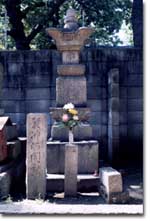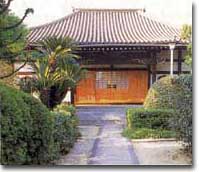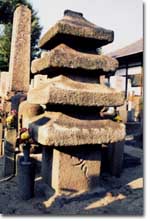|
|
|
|
| Higashinari-ku Top>Attractions |
| |
|
| |
Myoho Temple and Keichu Relics |
|
| |
|
| Myoho Temple |
|
| This temple is said to have
been founded by Shotoku Taishi (574-622). Keichu, the founder of the
study of ancient Japanese thought and culture, was resident priest
from 1679 to 1690. The shrine also is known to have been a scholastic
training hall. Currently, it is a cultural property of Osaka Prefecture.
|
| Location: 4-16-50
Oimazato, Higashinari-ku |
|
|
| Keichu Relics |
|
The precincts of Myoho Temple were designated
as a cultural property of Osaka Prefecture in 1949. Keichu, the founder
of the study of ancient Japanese thought and culture, was a resident
priest of Myoho Temple for 11 years from 1679 to 1690 and exerted
himself in his studies. His father was Shimokawa Zenbei Motokane,
who served the then feudal lord of Amagasaki, Aoyama Taizo Kosuke
Yukimasa with 250 koku (a unit of measurement of capacity used
in former days) stipend. Keichu was born in 1640 as the third child
of his family in Amagasaki. When he was 11, he entered the priesthood
and later studied at Mount Koya. After he became the resident priest
at Myoho Temple, he devoted himself to study of ancient Japanese thought
and culture. Included among his writings were the well-known "Manyo
Daisho-ki" (commentary to "Manyo-shu," the oldest collection of waka
poems in Japan), commissioned by Tokugawa Mitsukuni, then feudal lord
of Mito clan, and many other texts.
In 1690, after his mother's death at the temple, Keichu moved to Enjuan
in current Esashimachi in Tennoji-ku and died at the age of 62 in
1701. Myoho Temple temporarily declined around Horeki Era (1751),
but after Hakuchu Hoten took the position of the resident priest,
he advocated the faith of Daikokuten (the god of wealth) to improve
the tide of the times. It was widely known, as demonstrated by the
saying, "In the south, there is Ebisu God in Imamiya, and in
the east, there is Daikoku God in Imazato" and many people visited
there.
In the precincts of Myoho Temple, there is a tower erected for the
repose of Keichu, and his mother's tomb. |
| Location: Myoho Temple, 4-16-50
Oimazato, Higashinari-ku |
|
|
|
|
| |
| Homyo Temple |
|
| Homyo Temple was created
in 1318 by the holy priest Homyo, who revived the Yuzu Dainenbutsu
(invocation to Buddha) Sect. Two stone pagodas called "Ganzuka" in
the precincts are well known. |
| Location: 3-16-28 Fukaeminami,
Higashinari-ku |
|
|
| Ganzuka |
|
Two stone pagodas called
"Ganzuka" stand in the precincts of Homyo Temple. One is marked with
the year 1262 and the other with 1339. There is a legend related to
these pagodas. Once upon a time, the archery master Kiyohara Keibunojo
Masaji went hunting with his men, but unfortunately, they did not
have any luck. On the way back, they saw a group of wild geese and
shot the one in the front. Mysteriously, the head of the goose was
missing. They looked around, but could not find it. Next winter, they
shot a female goose. Under her wing was the dry head of the male goose.
When the priest Homyo heard this story, he was so deeply impressed
by the love of this pair of geese that he made a pair of four-story
pagodas to pray for them. This, they say, is the origin of Ganzuka.
|
| Location: Homyo Temple,
3-16-28 Fukaeminami, Higashinari-ku |
|
|
|
| Higashinari-ku Top>Attractions |



